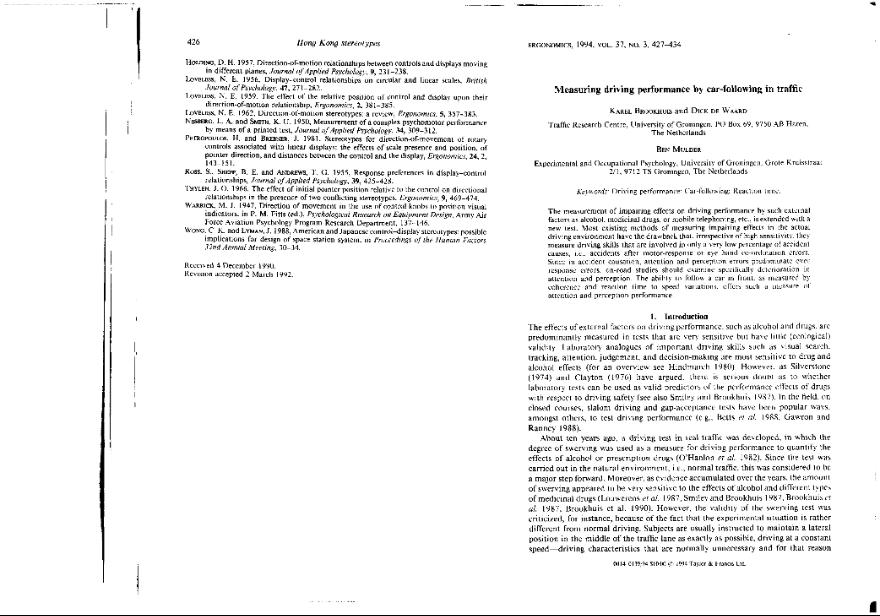Measuring driving performance by car-following in traffic

Contenido multimedia no disponible por derechos de autor o por acceso restringido. Contacte con la institución para más información.
| Tag | 1 | 2 | Valor |
|---|---|---|---|
| LDR | 00000nab a2200000 i 4500 | ||
| 001 | MAP20071019458 | ||
| 003 | MAP | ||
| 005 | 20080418115817.0 | ||
| 007 | hzruuu---uuuu | ||
| 008 | 940602e19940301gbr|||| | |00010|eng d | ||
| 035 | $a6800012720 | ||
| 040 | $aMAP$bspa | ||
| 084 | $a874 | ||
| 100 | 1 | $0MAPA20080238797$aBrookhuis, Karel A. | |
| 245 | 1 | 0 | $aMeasuring driving performance by car-following in traffic$cKarel Brookhuis , Dick de Waard, Ben Mulder |
| 520 | $aThe measurement of impairing effects on driving performance by such external factors as alcohol, medicinal drugs, or mobile telephoning, etc., is extended with a new test. Most existing methods of measuring impairing effects in the actual driving environment have the drawback that, irrespective of high sensitivity, they measure driving skills that are involved in only a very low percentage of accident causes, accidents after motor-response or eye-hand co-ordination errors. Since in accident causation, attention and perception errors predominate over response errors, on-road studies should examine specifically deterioration in attention and perception. The ability to follow a car in front, as measured by coherence and reaction time to speed variations, offers such a measure of attention and perception performance | ||
| 650 | 1 | 1 | $0MAPA20080550653$aErgonomía |
| 650 | 1 | 1 | $0MAPA20080600389$aComportamiento humano |
| 650 | 1 | 1 | $0MAPA20080599751$aAccidentes de tráfico |
| 650 | 1 | 1 | $0MAPA20080613242$aCausas de los accidentes |
| 650 | 1 | 1 | $0MAPA20080585266$aFactores de riesgo |
| 650 | 1 | 1 | $0MAPA20080542757$aAlcohol |
| 650 | 1 | 1 | $0MAPA20080540821$aDrogas |
| 650 | 1 | 1 | $0MAPA20080602871$aPercepción del riesgo |
| 650 | 1 | 1 | $0MAPA20080588366$aTiempo de reacción |
| 650 | 1 | 1 | $0MAPA20080628543$aPsicosociología de la prevención |
| 650 | 1 | 1 | $0MAPA20080539948$aTests |
| 700 | 1 | $0MAPA20080119027$aWaard, Dick de | |
| 700 | 1 | $0MAPA20080030254$aMulder, Ben | |
| 740 | 0 | $aErgonomics | |
| 773 | 0 | $tErgonomics$dLondon and Washington$gVol. 37, nº 3, March 1994 ; p. 427-434 |

